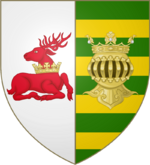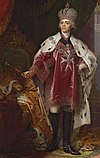House of Welsbach: Difference between revisions
No edit summary |
|||
| Line 79: | Line 79: | ||
|} | |} | ||
====Johnine | ====Residences of the Johnine Welsbachers==== | ||
<gallery class="center"> | |||
DD-Schloss-gp.jpg|Karnitz Royal Palace | |||
Pillnitz-Wasseransicht.jpg|Augustbrunn Palace | |||
</gallery> | |||
===Nestorine branch=== | ===Nestorine branch=== | ||
====House of Amretz-Herzogau-Amsern==== | ====House of Amretz-Herzogau-Amsern==== | ||
Revision as of 21:54, 25 September 2021
This article is incomplete because it is pending further input from participants, or it is a work-in-progress by one author. Please comment on this article's talk page to share your input, comments and questions. Note: To contribute to this article, you may need to seek help from the author(s) of this page. |
| House of Welsbach Haus Welsbach | |
|---|---|
| Royal dynasty | |
 Stem coat of arms of the Welsbach family | |
| Country | Mascylla, Rovina, Valimia |
| Founded | approx. 12th century |
| Founder | Adalbert I, Count of Welsbach |
| Current head | Karl Georg, Prince of Welsbach-Gehrach (Johnine branch) Stanislava I of Rovina (Nestorine branch) |
| Titles | List
|
| Cadet branches |
|
The House of Welsbach (Hesurian: Haus Welsbach) is a Mascyllary royal house and dynasty and one of the oldest royal families in Berea, having produced counts, princes, dukes, grand dukes, Valimian and Rovinan kings and Valimian emperors.
The Welsbach family, tracing back to the 12th century and the city of Welsbach, was divided as two separate branches following Dilisme's War and the Peace of Westmarke in 1297, the Johnine and Nestorine branches. The house historically ruled large areas of central Mascylla in the modern states of Falia and Therunder-Welsbach, assuming control over Ausern by 1260, Karnitz by 1310 and Phalya in the late 14th century. The Johnine branch, considered to be the senior Welsbach line, was elevated to a ducal and later grand ducal title in 1613, while the Nestorine branch was further divided into the cadet branches of the grand ducal Houses of Amretz-Herzogau-Amsern and Welsbach-Gehrach in the 1650s. The marriage of George Augustus of Welsbach to Helen the Great of Valimia introduced the less prominent Johnine Welsbachers as the rulers of the Kingdom and later Empire of Valimia, ruling in personal union with the Grand Duchy of Welsbach since 1637.
Aiding Aldia in the War of the Five Kings and the unification of Mascylla, the Grand Duchy of Welsbach was elevated to the status of Kingdom while continuing its personal union to Valimia. The Norbertine branch continued to rule Phalya and Amretz as grand dukes and its agnates achieved the Rovinan title of King in the 19th century which it retained until today.
Welsbachers
Johnine branch
The generally considered senior Johnine line of the Welsbachers consolidated the territorial integrity of Welsbach proper and ruled as Dukes (1297–1613), Grand Dukes (1613–1793) and Kings of Welsbach (1793–1923). They also played a central role in Valimian politics as its ruling royal and later imperial dynasty (1637–1922), simultaneously ruling Welsbach under a personal union known as Welsbach–Valimia. The 1793 aftermath of the War of the Five Kings enabled the Johnine Welsbachers to ascend to the title of King in Welsbach and receive territorial cessions from the Kingdom of Adwhin, while being subordinate to the Aldian kings of Mascylla. The collapse of the Valimian Empire after the Great War in 1922 forced the Johnine Welsbach monarchy to abandon the Valimian throne and dissolve the personal, before Charles Frederick III lost his Welsbach throne due to the Mascyllary Revolution in 1923 as well.













